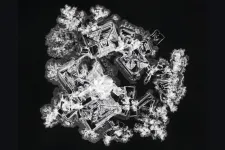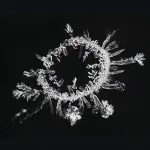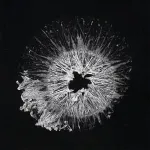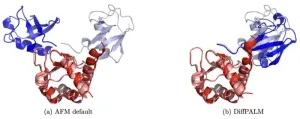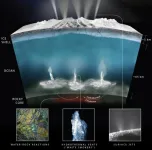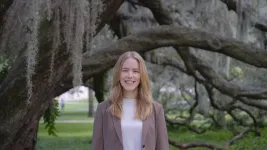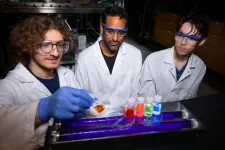(Press-News.org) TALLAHASSEE, Fla. — Imagine zooming in on a dried drop of salt solution — each pattern a unique masterpiece, reminiscent of abstract art, yet no larger than the size of a penny.
New research by scientists in the Florida State University Department of Chemistry and Biochemistry uses the patterns formed by a dried salt solution to train a machine learning algorithm that can identify the chemical composition of different salts. The work will be published in the Proceedings of the National Academy of Sciences.
“We are taking chemical fingerprints of different salts,” said Oliver Steinbock, Cottrell Professor of Chemistry. “Thinking of sodium chloride, or table salt, for example — among all samples of this type, they always look similar. There are differences from sample to sample, but all examples are distinct enough from other types that we can tell what kind of salt it is.”
When a salt solution dries, all sorts of forces are at play. Chemists have studied how fluid motion, crystal growth, environmental factors and other processes interact to determine the deposit pattern. The FSU researchers approached the problem from the opposite direction: If presented with a pattern of a dried solution droplet, could they determine what type of salt it was?
To do that, the researchers recorded 7,500 photos of 42 different types of salt stains. Using a new software approach, they translated each image into 16 parameters that can be rapidly analyzed by machine learning methods. The parameters capture features such as deposit area, compactness and texture. Each image was translated into numbers that in subtle ways encode the patterns’ arrangement of tiny crystals in rings, needles and leaf-like shapes.
To test their program’s ability to predict composition, the researchers analyzed additional images that were not part of the initial dataset. These programs successfully identified the correct salt in 90% of attempts.
“We were surprised at how well this worked,” Steinbock said. “Who would think that from a photo, you can tell the difference between sodium chloride and potassium chloride? They look very similar in the pictures. But the method is very good.”
The researchers plan to add to the training dataset by analyzing hundreds of thousands of new images, which would make their tool even more accurate and versatile. This vast number calls for lab automation, and such a robotic drop imager is currently being tested in Steinbock’s group.
“The difference between a human doing this and a computer is that the computer and our software can do this quantitatively,” Steinbock said. “If I were to present you 7,500 images, you would be confused. But the computer gets better and better with more and more images.”
The ability to quickly provide insight into the chemical composition of a sample from a photograph has many potential applications. For example, outfitting a rover exploring another planet with a full chemistry lab would be difficult and expensive, but a camera offers a cheap and lightweight alternative. Other scenarios, such as testing materials for lab safety, rapid screening for suspected drugs or low-cost blood analysis in places without access to hospitals, offer other potential applications.
Another benefit of this approach is that it only requires a minute amount of material. With just a few milligrams that make up a salt deposit, users could understand what they are likely handling and inform their decisions about how to proceed.
“If you want to have a rough idea of what that stain or spill is on a lab bench, you might use this as a cursory, first-step analysis,” said Bruno Batista, a senior researcher in Steinbock’s lab and the paper’s lead author.
Co-authors on this paper were Semhare Tekle, an undergraduate researcher in Steinbock’s lab; Jie Yan, a professor in the Department of Computer Science at Bowie State University; and Beni Dangi, an associate professor in the Department of Chemistry at Florida A&M University. This project was supported by NASA.
To see more images of salt patterns analyzed by Steinbock’s lab, visit the SaltScapes Gallery at his group’s website.
###
END
Nearly all the neural networks that power modern artificial intelligence tools such as ChatGPT are based on a 1960s-era computational model of a living neuron. A new model developed at the Flatiron Institute’s Center for Computational Neuroscience (CCN) suggests that this decades-old approximation doesn’t capture all the computational abilities that real neurons possess and that this older model is potentially holding back AI development.
The new model developed at CCN posits that individual neurons exert more control over their surroundings than previously thought. The updated neuron model could ultimately lead to more powerful artificial neural ...
Proteins are the building blocks of life, involved in virtually every biological process. Understanding how proteins interact with each other is crucial for deciphering the complexities of cellular functions, and has significant implications for drug development and the treatment of diseases.
However, predicting which proteins bind together has been a challenging aspect of computational biology, primarily due to the vast diversity and complexity of protein structures. But a new study from the group of Anne-Florence Bitbol at EPFL might now change all that.
The team of scientists, ...
The world of artificial intelligence (AI) has recently seen significant advancements in generative models, a type of machine-learning algorithms that “learn” patterns from set of data in order to generate new, similar sets of data. Generative models are often used for things like drawing images and natural language generation – a famous example are the models used to develop chatGPT.
Generative models have had remarkable success in various applications, from image and video generation to composing music and to language modeling. The problem ...
We’ve all seen the surreal footage in nature documentaries showing hydrothermal vents on the frigid ocean floor—bellowing black plumes of super-hot water—and the life forms that cling to them. Now, a new study by UC Santa Cruz researchers suggests that lower-temperature vents, which are common across Earth's seafloor, may help to create life-supporting conditions on "ocean worlds" in our solar system.
Ocean worlds are planets and moons that have—or had in the past—a liquid ocean, often under an icy shell or within their rocky interior. In Earth's solar system, several of Jupiter's and Saturn's moons are ocean worlds, and ...
Media Contact:
John Dudley
(814) 490-3290 (cell)
jjdudley@usf.edu
TAMPA, Fla. (June 24, 2024) – Mindfulness – focusing on the present moment – can improve sleep, reduce stress and improve overall health. A new University of South Florida-led study helps explain why.
Researchers studied 144 nurses over two weeks to see how well they could stay focused on the present and how often they fixated on negative thoughts. The nurses completed surveys three times a day and reported their sleep quality the following morning.
The findings shed light on how mindfulness relates to emotion ...
The first issue of JACC, the flagship journal of the American College of Cardiology, under new Editor-in-Chief Harlan M. Krumholz, MD, SM, FACC, publishes today, ushering in a new era of one of the world’s leading scholarly journals.
“I envision JACC, with all its strengths, as a transformative platform for building community, elevating strong science, influencing clinical practice, supporting career development, and improving patient outcomes.” Krumholz said in his Editor’s Page. “JACC and its group of journals can play a pivotal role in serving our community and shaping the future.”
Under his editorship, JACC will be guided by ...
Using an instrument on the 4.1-meter Southern Astrophysical Research Telescope, researchers obtained the first astronomical spectrum using skipper charge-coupled devices (CCDs).
The results were presented on June 16 at the Society of Photo-Optical Instrumentation Engineers Astronomical Telescopes + Instrumentation meeting in Japan by Edgar Marrufo Villalpando, a physics PhD candidate at the University of Chicago and a Fermilab DOE Graduate Instrumentation Research Award Fellow.
“This is a major milestone for skipper-CCD technology,” said Alex Drlica-Wagner, a cosmologist at the U.S. Department of Energy’s Fermi ...
Researchers at the University of Toronto have harnessed a bacterial immune defense system, known as CRISPR, to efficiently and precisely control the process of RNA splicing.
The technology opens the door to new applications, including systematically interrogating the functions of parts of genes and correcting splicing deficiencies that underlie numerous diseases and disorders.
“Almost all human genes produce RNA transcripts that undergo the process of splicing, whereby coding segments, called exons, are joined together and non-coding segments, called introns, are removed and typically degraded,” said Jack Daiyang Li, first author on the study and PhD student ...
Oak Brook, IL – The Society for Laboratory Automation and Screening (SLAS) will launch NexusXp, its new interactive pavilion at SLAS2025 to showcase collaborative and integrated lab automation scenarios. NexusXp combines Nexus, the Latin word for link or connection where multiple elements meet, with the modern “Xp” to signify the “Xperience” of making that critical link or connection. Through this new pavilion, SLAS will demonstrate how automation integration transforms research and enables scientific breakthroughs.
“NexusXp is an exclusive event or attendee ...
AMES, Iowa – A Google Cloud video takes you inside a company data center in
southwest Iowa’s Council Bluffs.
There you are, in the middle of a long, industrial corridor. You slowly move past rack after rack after rack of the computer servers that are, Google says, “helping to keep the internet humming 24/7.”
Part of that hum is the power that keeps those data centers up and running.
“Think about when you use your computer,” said Matthew ...
